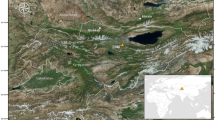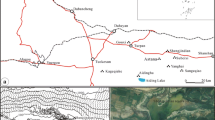Abstract
This paper lays out archaeobotanical evidence of cereals and fruits from 5th–2nd millennium B.C. sites in Turkmenistan (Anau, Gonur) and Uzbekistan (Djarkutan). Our current research program (1989-present) focuses on systematic recovery of botanical remains in their stratigraphic context. The cereals from these sites includeHordeum vulgare L. ssp.vulgare (6-row barley) andTrilicum aestivum L. s.l. (bread wheat). The presence of plump grains of 6-row barley and bread wheat may indicate that small-scale irrigation was practised at Anau as early as the Chalcolithic period. The possibility is also raised that these plump-grained types may have come from the east rather than through northern Iran. Fruit pit remains ofVilis vinifera L. (grape) andPislacia (pistachio) make their first significant appearance in Bronze Age deposits.
Similar content being viewed by others
References
Bakhteyev FKh, Yanushevich ZV (1980) Discoveries of cultivated plants in the early farming settlements of Yarym-Tepe I and Yarym-Tepe II in northern Iraq. J Archaeol Sci 7: 167–178
Costantini L (1984) The beginning of agriculture in the Kachi Plain: the evidence of Mehrgarh. In: Allchin B (ed) South Asian archaeology 1981. Cambridge University Press, Cambridge, pp. 29–33
Costantini L (1987) Vegetal remains. In: Stacul G Prehistoric and protohistoric Swat, Pakistan (c. 3000–1400 B.C.). IsMeo, Rome: 155–165
Costantini L, Biasini L (1985) Agriculture in Baluchistan between the 7th and the 3rd millennium BC. Newsle Baluchistan Stud 2 (spring): 16–30
Harlan HV (1914) Some distinctions in our cultivated barleys with reference to their use in plant breeding. Ph.D. dissertation, University of Minnesota
Harlan, JR (1968) On the origin of barley. In: Barley: origin, botany, culture, winter hardiness, genetics, utilization, pests. Agriculture Handbook no. 338. Agricultural Research Service, Washington DC:, 9–31
Harris DR, Gosden C, Charles MP (1996) Jeitun: Recent excavations at an early Neolithic site in southern Turkmenistan. Proc Prehistoric Soc 62: 423–442
Harrison N (1995) Preliminary archaeobotanical findings from Anau, 1994 excavations. In; Hiebert F (ed) Progress Report, Harvard-IuTAKE Excavations at Anau South, Turkmenistan. Report on file, Peabody Museum, Cambridge MA, pp. 28–35
Helbæk H (1969) Plant collecting, dry-farming, and irrigation agriculture in prehistoric Deh Luran. In: Hole F, Flannery KV, Neely JA (eds) Prehistory and human ecology of the Deh Luran Plain. Memoir 1, University of Michigan Museum of Anthropology, Ann Arbor, pp 383–426
Hiebert FT (1994) Origins of the Bronze Age civilization in Central Asia. Peabody Museum, Cambridge MA
Hiebert FT (ed) (1995) Progress Report, Harvard-IuTAKE excavations at Anau South, Turkmenistan. Report on file, Peabody Museum, Cambridge MA
Hillman GC (unpublished) Criteria for distinquishing rachis remains of naked (free-threshing) 4x and 6x wheats. Photocopy of notes
Jarrige J-F (1987) Problèmes de la datation du site néolithique de Mehrgarh, Baluchistan, Pakistan. In: Aurenche O, Evin J, Hours F (eds) Chronologies du Proche Orient/Chronologies in the Near East. Brit Archaeol Rep Int Ser 379(1): 381–386
Kamakhina GL (1994) Kopetdagh-Khorassan flora: regional features of central Kopetdagh. In: Fet V, Atamuradov Khl (eds) Biogeography and ecology of Turkmenistan. Kluwer, Dordrecht, pp. 129–148
Kurbansakhatov K (1985) Eneolithic Anau. Ashgabad
Masson VM, Sarianidi VI (1972) Central Asia: Turkmenia before the Achaemenids. Thames and Hudson, London
Miller NF (1982) Economy and Environment of Malyan, a Third Millenium B.C. Urban Center in Southern Iran. Ph. D. Dissertation. Dept. of Anthropology, University of Michigan, Ann Arbor.
Miller NF (1984) The use of dung as fuel: an ethnographic model and an archaeological example. Paléorient 10/2: 71–79
Miller NF (1993) Preliminary archaeobotanical results from the 1989 excavation at the central Asian site of Gonur Depe, Turkmenistan. Information Bull 19: 149–163
Minnis PE, LeBlanc SA (1976) An efficient, inexpensive arid lands flotation system. American Antiq 41: 491–493
Popov KP (1994) Trees, shrubs, and semishrubs in the mountains of Turkmenistan. In: Fet V, Atamuradov Khl (eds) Biogeography and ecology of Turkmenistan. Kluwer, Dordrecht, pp. 173–186
Pumpelly R (ed) (1908) Explorations in Turkestan, expedition of 1904. Publication 73, Carnegie Institution of Washington, Washington DC
Rosen AM (1992). Preliminary identification of silica skeletons from Near Eastern archaeological sites: An anatomical approach. In: Rapp GJ, Mulholland SC (eds) Phytolith systematics: emerging issues. Plenum, New York, pp 129–147
Schellenburg HC (1908) The remains of plants from the north Kurgan, Anau. In: Pumpelly R (ed) Explorations in Turkestan, expedition of 1904. Carnegie Institute of Washington, Washington DC, vol 2, pp 471–473
Stummer A (1911) Zur Urgeschichte der Rebe und des Weinbaues. Mitt Anthropol Ges Wien 41: 283–296
Vavilov NI ([1926] 1951) The origin, variation, immunity and breeding of cultivated plants (translation by K. Starr Chester). Chronic Bot 13, no. 1–6
Zohary D, Hopf M (1994) Domestication of plants in the Old World (2nd edn.). Clarendon Press, Oxford
Author information
Authors and Affiliations
Rights and permissions
About this article
Cite this article
Miller, N.F. Agricultural development in western Central Asia in the Chalcolithic and Bronze Ages. Veget Hist Archaebot 8, 13–19 (1999). https://doi.org/10.1007/BF02042837
Received:
Accepted:
Issue Date:
DOI: https://doi.org/10.1007/BF02042837




